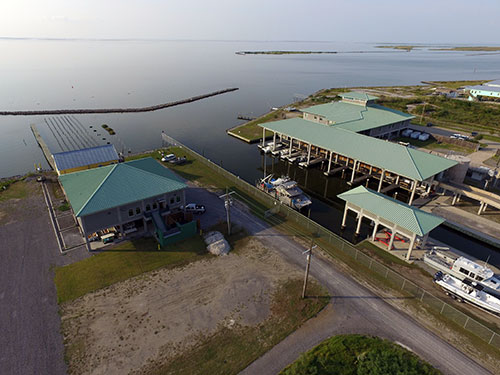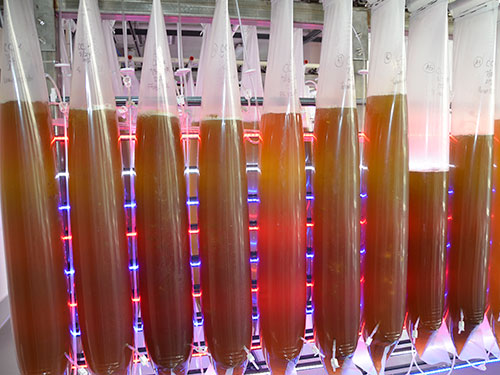Oyster Hatchery Marks 30 Years
The Grand Isle Oyster Hatchery is celebrating its Pearl Anniversary – 30 years – in 2023.

Originally started as a commercial hatchery by Gulf Shellfish Farms (GSF) in 1990 when natural oyster seed production was down, Louisiana Sea Grant bivalve specialist John Supan was loaned to GSF to manage the operation and train oystermen in remote setting techniques. In 1993, when the commercial venture ended because natural seed rebounded, Louisiana Sea Grant acquired it and turned it into a research facility with Supan leading the effort.
Twelve years later, Hurricane Katrina devasted the hatchery with tens of millions of oyster larvae lost. It took two years for hatchery operations to resume before it was destroyed again by Hurricane Gustav in 2008. By 2009, operations moved across Grand Isle and restarted at the Louisiana Department of Wildlife and Fisheries (LDWF) lab. A new hatchery building was funded in 2013 with money from a Natural Resource Damage Assessment (NRDA) grant following the 2010 BP Oil Spill. In August of 2015, the new facility was designated the Michael C. Voisin Oyster Hatchery after Voisin, a leader and advocate for the oyster industry who passed away in 2013. While the main hatchery building was spared by Hurricane Ida in 2021, the storm destroyed the attached camp that housed Sea Grant personnel who operate the facility.
Natural disasters haven’t stopped hatchery operations though. Interim director and operations manager Elizabeth Robinson and her team have taken the initiative to keep production on task. The hatchery has added new equipment to their flow-through system, including a bubble bead filter and a protein skimmer, to assist in the removal of suspended sediments and organic materials. In conjunction with a tangential flow filter (TFF), bay water is filtered down to 0.1 microns, providing extremely clean water to raise algae (which the bivavles eat) and oysters. At peak operations, the hatchery cycles through four to eight thousand gallons of bay water a day. When the Mid-Barataria freshwater diversion becomes operational, the hatchery will have to switch to a recirculating system – a process that is more expensive.

Currently, the hatchery supplies LDWF with pediveliger larvae – “eyed” larvae with a foot. Pediveliger larvae use their foot to search for a suitable substrate to settle on, such as existing or recycled oyster shell (spat on shell). LDWF sets larvae on oyster shell and then deploys the spat on shell to restore public seed grounds for the oyster industry. The hatchery also produces larvae and seed for scientific research and the Alternative Oyster Culture (AOC or off-bottom oyster aquaculture) industry.
While the hatchery’s production technology is at industry standards, Robinson would like to create a water quality monitoring station at the facility’s broodstock farm and acquire a fluorometer for the larval production room. The fluorometer would allow hatchery researchers to monitor how the oysters are feeding on live algae. The hatchery site also includes an AOC demonstration farm that houses broodstock from different bays across the state – Calcasieu, Sister Lake, Vermillion and Hackberry. The broodstock are contained in cages on longlines and also in bags that float at the top of the water column. Robinson and the hatchery team are working to update the farm gear to be more representative of what is currently used by industry.
Additionally, Robinson is building collaborations with researchers locally and nationwide. The hatchery is supporting research examining the utilization of probiotics to improve larval survival; serving as a grow-out site for the University of Southern Mississippi, where they are developing an oyster that is more tolerant to changes in salinity; and monitoring changes in marine phytoplankton and harmful algal blooms as part of NOAA’s Aquaculture Phytoplanton Monitoring Network. “I hope to eventually have the hatchery (and research lab) at full capacity conducting research simultaneously with oyster production,” Robinson said. “I would like to see us more involved in research than we are now.”
Fulfilling its primary goals, the hatchery produces quality oysters to benefit aquaculture, restoration and research needs. It also provides guidance to the industry by helping farmers set up their own nurseries or hatcheries. And, the team also participates in outreach ventures – attending events promoting oyster aquaculture, hosting workshops for growers, and educating teachers about bivalves and oyster production.
Tours of the Michael C. Voisin Oyster Hatchery can be scheduled. Anyone interested should contact Robinson at [email protected]. For more on the web, visit www.laseagrant.org/outreach/aquaculture/oyster-research-lab.
Join us on a virtual tour of the Michael C. Voisin Oyster Hatchery in Grand Isle and learn more about oysters and the important research being conducted.
